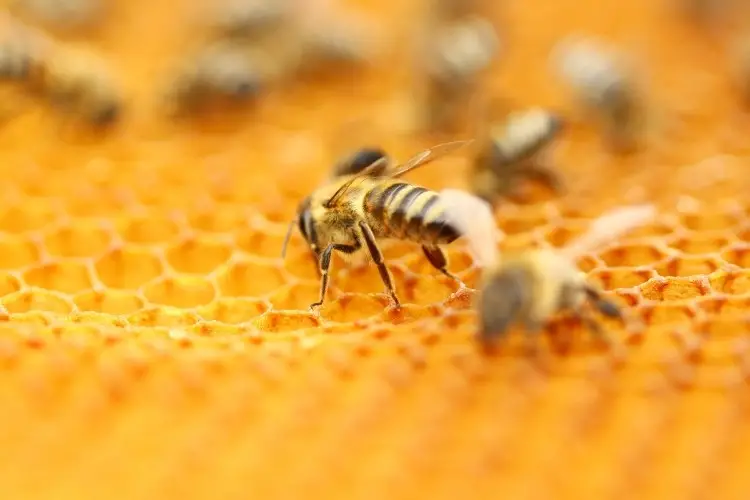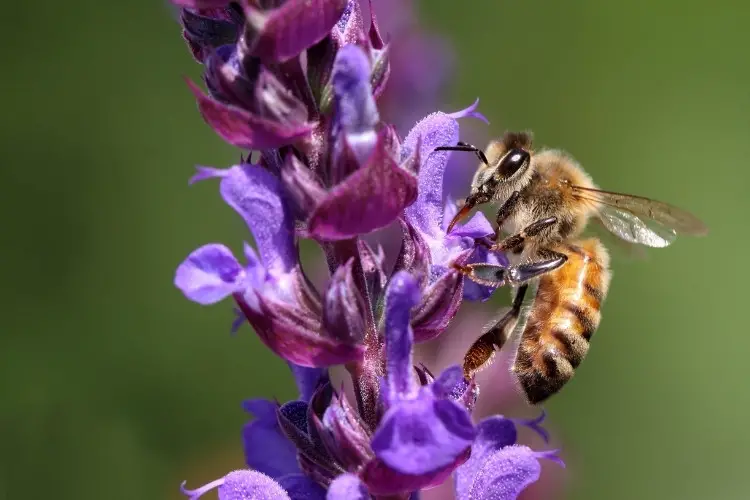Although we humans do love to eat honey, bees make it to ensure their survival, not ours. What they don’t eat they store in capped cells in the hive, so it’s there for future use.
Bees gather nectar to produce honey when the weather conditions are favorable and there are enough suitable nectar-producing flowers in bloom. Spring, summer, and the early part of fall (autumn) are usually the optimal time for honey making, but it also depends on where in the world you live.

Bees Make Honey When The Weather Conditions Are Favorable
Bees make honey in the warmer months of the year when there are plenty of nectar-rich flowers available. These conditions aren’t available all year round though, so bees must work hard to produce honey when the conditions are right.
If you live in the US, there is a larger variation in weather and favorable honey-making conditions. Between the months of March and early October, bees will be making honey in most parts of the country.
But if you live in Australia, bees make most of their honey from September through to March. Because Australia is such a large continent, different weather conditions occur in different areas, therefore the honey-making season may be longer or shorter depending on where you live.
The weather during these months is not guaranteed to be constantly suitable, however. Weather patterns can fluctuate in any season, so bees have to make the most of the conditions when they present themselves.
This means bees can still collect nectar in winter, as long as the air temperature is warm enough and there is nectar to collect.

The amount of honey that bees make doesn’t just try upon favorable weather conditions. There must also be enough nectar-rich flowers available for the bees to visit. In spring, summer and fall there are more nectar and pollen-rich flowers in bloom than at other times of the year.
The optimum time for making honey is during a nectar (or honey) flow. A nectar flow is characterized by an abundance of nectar-rich plants in flower all at the same time. Warm weather conditions and longer daylight hours all contribute to optimal nectar gathering conditions.
When Do Bees Stop Making Honey?
Bees stop making honey in winter, or at any time when weather conditions are unfavorable. That is in winter when the temperature is too cold for them to leave the hive.
When the temperature drops to between 50 to 57 degrees Fahrenheit (10 to 14 degrees Celsius) bees form what is known as a winter cluster where they huddle together to conserve heat. Bees must then rely on their stored honey as food.
Bees also can’t make much honey when there are not enough nectar-rich flowers in bloom. Bees will readily travel up to 1.5 kilometers away (1 mile) to access a good nectar source, but they prefer to work within 200 meters of the hive, therefore conserving their energy and maximizing their nectar collection.
The amount of honey produced will be affected too by a weak hive, or a hive that’s been invaded by disease or pests. Some parasites attack the individual bee and others will eat the honey harvest. A weak hive will have fewer healthy workers, and will therefore be forced to slow their honey production.
What Time Of Day Do Bees Make Honey?
Bees collect nectar during the day when the temperature is above 55 degrees Fahrenheit (13 degrees Celsius). However, turning nectar into honey takes time.
Even though it’s collected during the day when flowers are open, the whole process of honey ripening can take hours. The precise amount of time it takes depends on the moisture content, as well as the temperature within the hive.
Making honey involves adding enzymes and evaporating excess moisture until the honey has a moisture content between 14 and 18% when it’s considered ‘ripe’ and is ready to be capped. It begins when a foraging bee extracts the nectar from the flower and stores it inside her special honey stomach, known as a crop, to be transported back to the hive.
When her honey crop is full, she carries the nectar back to the hive where it is transferred to specialized worker bees. These bees continue the evaporation process by exposing the nectar on their proboscis to the warm air of the hive.
This process takes about twenty minutes, after which time the partially ripened honey is placed in a cell where exposure to the warm air of the hive results in more evaporation. The nectar is evaporated until it becomes honey, then is sealed with a wax capping.
Do Bees Die After Making Honey?
Although bees die after they sting you, a bee doesn’t die after making honey. In fact, honey does the opposite – it helps to sustain a bee’s life, especially during winter when it is a vital food source.
Making honey is an essential job for bees as it’s a major source of food for the colony. Bees need honey in order to ensure their individual survival and the survival of the colony.
Ripened nectar or honey provides all the energy and enzymes a bee needs to perform all the required tasks in and around the hive.
The only time bees might die after making honey is by human intervention, that is if we take too much from the hive and don’t leave enough honey stores to see the colony through Winter or extended spells of bad weather.
Do Bees Get Mad When You Take Their Honey?
Bees will most likely get mad if you take their honey. Honey is essential to their survival, so they will defend themselves against being robbed. But the degree to which they become aggressive depends upon the personality of the queen, and whether or not you have used smoke correctly.
When you take honey frames for harvest, the bees will perceive this action as a threat to the hive and act accordingly. The reaction of the bees can be softened by using cool white smoke as you conduct your inspection.
With a few gentle puffs of smoke, the bees retreat into the hive to focus on eating honey, because they think there is a fire. This takes their mind off you and allows you to continue your inspection.
When you take honey from your hive you must consider how many frames you will harvest. The number you leave depends upon a few factors, such as the weather, the health of the hive and the number of flowering plants that will be available in the future. It’s better to be cautious and take fewer than you first intended.
Summing Up…
Honey bees are crucial to a healthy environment. During many months of the year, they make honey, which is a vital food source that ensures the future of their species.
Bees don’t make honey all year round, though. Sometimes it’s just too cold and there are not enough suitable flowering plants around. That’s why bees make extra honey when the conditions are favorable, then store it inside their hive to eat all year round.
